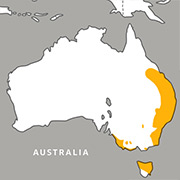Red-necked Wallaby
Macropus rufogriseus

About the Red-necked Wallaby

Geographic Range:

Class: Mammalia
Order: Diprotodontia
Family: Macropodidae
Genus: Notamacropus
Species: rufogriseus
The red-necked wallaby, also known as Bennett's wallaby, is a medium-sized marsupial native to Australia. They're known for their distinctive red-brown fur on their neck and shoulders, with a gray-brown body and a white underbelly. Wallabies are herbivorous and typically feed on grasses, leaves, and fruits.
Red-necked wallabies are found in a variety of habitats, including forests, grasslands, and coastal scrublands, and are known for their ability to adapt to changing environments. Wallabies are often hunted by humans for their skin. Here at ZNE, we support the Wildlife Trafficking Alliance, working to protect animals from the illegal trade.
Red-Necked Wallaby Facts
Committed to Conservation
Wallabies are often hunted by humans for their skin. Here at Zoo New England, we support the Wildlife Trafficking Alliance, working to protect animals from the illegal trade.
How you can Help
Practice ecotourism by supporting, visiting, or volunteering at organizations that protect wildlife. Do not buy products made from animals.
Appearance:
Members of the genus Macropus, meaning "long foot," red-necked wallabies are closely related to kangaroos and wallaroos, though wallabies tend to be smaller. With their powerful legs and tapered tails, macropods are well known for their hopping skills. Like all macropods, wallabies have very small or even non-existent vocal cords.
The species is referred to as "red-necked" because of the red-tinted fur on their necks. They have mostly coarse, thick, tawny gray fur, and white chests and bellies. Females have lighter-colored fur coats than males. Their muzzle, paws and feet are dark brown. Wallabies have powerful hind legs used to bound at high speeds and jump far distances, and their tapered, muscular tails help them balance.
Wallabies are marsupials. The word marsupial comes from the Latin word “marsupium,” which means pouch. Female wallabies use their pouches to carry their offspring, known as joeys, until they’re capable of leaving and continue to grow outside the pouch.
A wallaby’s teeth are flat for grinding and crushing leaves. In its lifetime, a wallaby will have four sets of molars erupt. As it ages, a wallaby’s teeth move slowly forward, eventually falling out of the jaw, making room for molars erupting behind.
Size:
- Males: 33 - 59 pounds, 2 - 3 feet (head-body length); 2.3 - 2.8 feet (tail length).
Male wallabies have a faster growth rate, growing up to twice as large as females. - Females: 24 – 34 pounds, 2 - 2.4 feet (head-body length); 2 - 2.6 feet (tail length)
- Birth: Less than 1 gram (0.04 ounce)
Diet:
Wallabies are herbivores, primarily grazing and browsing in areas of high elevation. They're also bulk-feeders, chewing mouthfuls of grass in each bite. In one studied population, grasses comprise 74% of their total diet. Wallabies also eat broad-leafed plants (non-grass forbs), vegetables, fruit, hay, ferns, and fungi.
Reproduction:
Wallabies will first mate when females are around 13 – 14 months of age. Males make a soft clucking noise during sexual interactions, whereas females hiss. Wallaby populations in Tasmania reproduce between January and July, with most joeys born in February and March. Mainland wallabies breed year-round, with most joeys born from December to February (Southern Hemisphere summer months).
Through embryonic diapause, a suspended state of pregnancy, wallabies are able to delay an embryo’s implantation in the uterus until conditions (like available daylight or an occupied pouch) improve. If the female has no pouch young, and mates near the end of her breeding season, she will not give birth until eight months later in the next breeding season. If wallabies are transferred to northern latitudes, they keep their seasonality and adjust the timing to give birth after the northern summer solstice.
Gestation is 29 days, and joeys are born tiny, hairless and underdeveloped. The baby must crawl up into its mother’s pouch, where it will attach to a nipple and remain for several months. Wallabies can produce two types of milk: one high-fat milk for the developing joey in the pouch, and a low-fat variety for joeys leaving the pouch. Juveniles continue to return to their mother’s pouch until about 9 months of age. They will continue to suckle for three to nine months thereafter.
Behavior:
This species is crepuscular, meaning they are most active at dusk and dawn. Often solitary, wallabies are found singly or in small groups (feeding groups of up to 30 wallabies).
Wallabies have an acute sense of smell and hearing. Their large ears can move 180 degrees independently, which helps them listen for predators. When threatened, wallabies thump their feet and make hoarse noises to alarm others. Though their vocal cords are underdeveloped, they can still growl and hiss.
Habitat/range:
Wallabies are found in Southeastern Australia and Tasmania. Their preferred habitat includes eucalyptus forests with grasses and shrubs making up the understory, but they can tolerate diverse habitats, including farmland.
Median Life Expectancy:
10 – 15 years in the wild
Fun Facts:
- A group of wallabies is called a mob.
- A male wallaby is called a buck, and a female is a doe.
You Can Find This Animal in the Outback Trail
Delayed delivery
If the time isn't right to give birth, a wallaby can delay her embryo's implantation in her uterus until conditions, like available daylight or an occupied pouch, improve.
You might also like
At Franklin Park Zoo:
At Stone Zoo:


